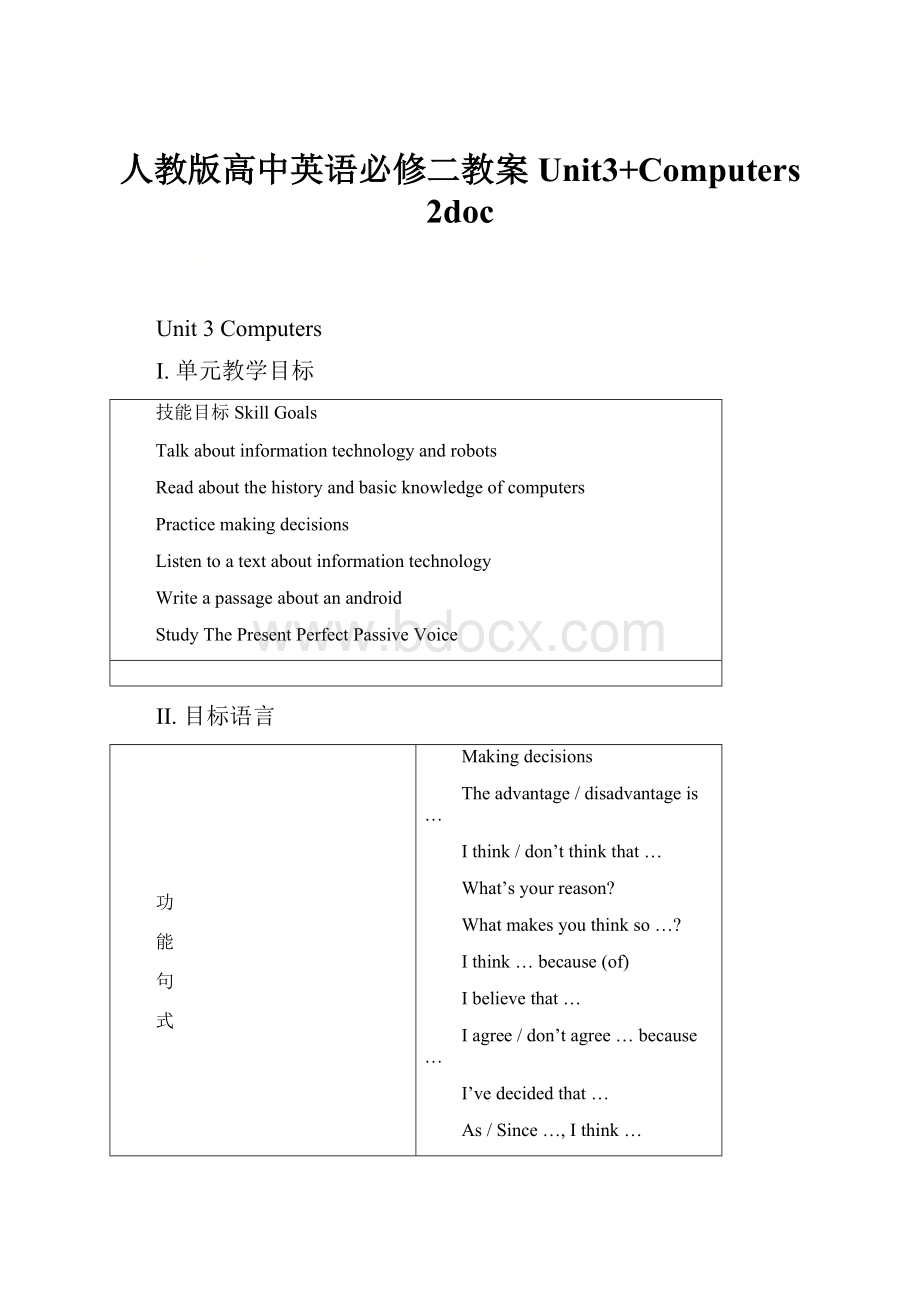人教版高中英语必修二教案Unit3+Computers 2doc.docx
《人教版高中英语必修二教案Unit3+Computers 2doc.docx》由会员分享,可在线阅读,更多相关《人教版高中英语必修二教案Unit3+Computers 2doc.docx(34页珍藏版)》请在冰豆网上搜索。

人教版高中英语必修二教案Unit3+Computers2doc
Unit3Computers
I.单元教学目标
技能目标SkillGoals
Talkaboutinformationtechnologyandrobots
Readaboutthehistoryandbasicknowledgeofcomputers
Practicemakingdecisions
Listentoatextaboutinformationtechnology
Writeapassageaboutanandroid
StudyThePresentPerfectPassiveVoice
II.目标语言
功
能
句
式
Makingdecisions
Theadvantage/disadvantageis…
Ithink/don’tthinkthat…
What’syourreason?
Whatmakesyouthinkso…?
Ithink…because(of)
Ibelievethat…
Iagree/don’tagree…because…
I’vedecidedthat…
As/Since…,Ithink…
词
汇
1.四会词汇
solve,explore,anyhow,humanrace,signal,goal,type,arise,electronic
2.认读词汇
calculate,universal,simplify,sum,operator,logical,logically,technology,technological,revolution,artificial,intelligence,intelligent,reality,personal,personally,tube,total,totally,network,web,application,finance,mobile,rocket,happiness,download,virus,coach,appearance,character,mop,niece,abacus,calculator,PC,laptop,PDA,analytical,mathematical,designer,transistor,chip,Mars,programmer,android,teammate,naughty,spoil
3.词组
from…on,goby,asaresult,so…that…,inaway,withthehelpof,dealwith,watchover
结
构
ThePresentPerfectPassiveVoice
重
点
句
子
1.Overtimemymemoryhasdevelopedsomuchthat,likeanelephant,Inever
forgetanythingIhavebeentold!
2.AndmymemorybecamesolargethatevenIcouldn’tbelieveit!
3.Astimehadgoneby,Ihavebeenmadesmallerandsmaller.
4.Ihavebeenusedinofficesandhomessincethe1970s.
5.Sincethe1970smanynewapplicationshavebeenfoundforme.
6.Ihavealsobeenputintorobotsandusedtomakemobilephonesaswellashelpwithmedicaloperations.
7.IhaveevenbeenputintospacerocketsandsenttoexploretheMoonandMars.
III.教材分析与教材重组
1.教材分析
本单元以computers为话题,旨在通过单元教学,综合听、说、读、写等多种形式,使学生了解计算机和信息技术的产生和发展过程及其在我们的学习、工作、娱乐等生活中所起的重要作用,激发学生对信息技术的兴趣。
1.1Warmingup提供几幅与计算机有关的图片,形象地说明了计算机的发展历程,并用三个问题引发学生对这一话题的思考,从而起到热身的作用。
1.2Pre-reading根据文章内容预设问题,检查学生对computers相关知识及应用的了解。
学生对computers的了解可能参差不齐,这更能激发学生想获取更多知识的欲望,从而引出下面的阅读文章——WHOAMI?
。
1.3Reading中以别致的标题WHOAMI?
引起学生的好奇心,使学生迫不急待地阅读这篇文章,并判断出“I”是computer,从而对文章的内容印象更深刻。
文章以第一人称的形式按时间先后顺序讲述了computers的产生、发展和现状,并用拟人化的口吻表达了computers乐于为人类服务的精神。
1.4Comprehending1通过scanning的方式完成反映计算机发展历程的时间进程;2通过填表的形式帮助学生宏观梳理文章结构,找出每个段落的主题句(论点)及具体的支持性论据;3是读后讨论,要求学生结合自己的生活实际讨论计算机如何改变了我们的生活。
1.5Learningaboutlanguage分词汇(Discoveringusefulwordsandexpressions)和语法(Discoveringusefulstructures)两大部分。
Discoveringusefulwordsandexpressions1根据单词释义写出相对应的词汇,考查学生对WHOAMI?
文章中的重要词汇及短语的理解。
2是以对短文填词完型的形式考查学生对几个重点词汇在篇章中的运用。
3以personalize的形式练习几个表时间状语的短语的用法。
Discoveringusefulstructures是学习现在完成时的被动语态。
1是让学生根据例子提示在WHOAMI?
文章中找出两个含有现在完成时的被动语态的句子,初步了解这一时态的形式。
2是根据例句提示把所给的现在完成时句子变为被动语态。
3通过欣赏一首小诗进一步理解现在完成时的被动语态的用法。
1.6Usinglanguage从听、说、读、写四个部分强化学生的语言应用能力。
ListeningandSpeaking以“信息技术”为子话题展开听说活动。
说的活动主要是就信息技术各种形式的优势和劣势展开讨论,并用所给的表reasoning的功能项目展开讨论,决定哪种类型是最有用的。
Reading,speakingandwriting以“芯片”为子话题展开读、说和写的活动。
阅读文章介绍了叫一个叫Andy的机器人的故事,故事以第一人称的拟人话手法来写,说明了计算机芯片在机器人领域的应用。
1根据文章内容完成Andy的个人简历,检验学生对一些具体信息的掌握。
2激发学生的想象力,让他们设计出自己的机器人,并能用简历的形式描述。
3是写作任务,学生根据所给范文和2中的notes写篇文章,介绍自己设计的机器人。
1.7LISTENING材料的话题衔接Reading,speakingandwriting的话题,介绍了三个不同的机器人。
1听前预测。
2听大意。
3听细节完成表格。
1.8TALKING根据假设情境在听力的基础上展开讨论,讨论每个机器人的优势和劣势,最终做出决定并给出理由,同时也是对前面所学的功能项目的复习应用。
1.9USINGWORDSANDEXPRESSIONS通过各种形式练习本单元的重点词汇和短语。
USINGSTRUCTURES设计了各种活动练习巩固本单元的语法项目。
1.10LSITENINGTASK也是以机器人为话题,从机器人的权利这一角度展开听力活动,引发学生思考机器人和人类的异同点及机器人应该拥有的权利。
1.11READINGTASK阅读材料介绍了一种未来机器人——体育机器人,文章为科幻类型,预测了机器人发展的前景。
1.12SPEAKINGTASK是任务型活动,紧接着READINGTASK的话题,让学生运用想象力俩俩结对做一个针对体育机器人的采访,为校报准备新闻素材。
1.13WRITINGTASK是SPEAKINGTASK的书面输出活动,根据采访活动内容和范文结构提示写篇采访稿。
2.教材重组
2.1将Warmingup、Pre-reading、
Reading和Comprehending整合在一起,上一节“精读课”。
2.2将LearningaboutLanguage和Workbook中的USINGWORDSANDEXPRESSIONS及USINGSTRUCTURES整合为一节“语言学习课”。
2.3将Usinglanguage中的ListeningandSpeaking设计为一节“听说课”。
2.4将Usinglanguage中的Reading,speakingandwriting及Workbook中的LISTENING和TALKING整合为一节“综合技能课
(一)”。
2.5将Workbook中的LISENINGTASK、READINGTASK、SPEAKINGTASK以及WRITINGTASK整合为另一节“综合技能课
(二)”。
3.课型设计与课时分配(经教材分析,根据学情,本单元可以用五课时教完)
1stPeriodIntensivereading
2ndPeriodLanguagestudy
3rdPeriodListeningandSpeaking
4thPeriodIntegrativeskills(I)
5thPeriodIntegrativeskills(II)
V.分课时教案
TheFirstPeriodIntensiveReading
Teachinggoals教学目标
1.Targetlanguage目标语言
a.重点词汇和短语
simplifylogicallytechnologicalrevolutionsolvefrom…onpersonal
asaresulttotallyso…thatnetworkWebapplicationexploreanyhowhumanrace
b.重点句子
Overtimemymemoryhasdevelopedsomuchthat,likeanelephant,IneverforgetanythingIhavebeentold!
AndmymemorybecamesolargethatevenIcouldn’tbelieveit!
2.Abilitygoals能力目标
Enablestudentstolearnaboutthedevelopmentandhistoryofcomputers.
3.Learningabilitygoals学能目标
Byfinishingthetimelineandthechart,helpstudentsgraspthebasicstructureandmainideaofthepassage.
Teachingimportantanddifficultpoints教学重难点
Understandhowdetailsareusedtosupporttopicsentences.
Teachingmethods教学方法
Prediction,scanninganddiscussion.
Teachingaids教具准备
Projectorandtaperecorder.
Teachingprocedures&ways教学过程与方式
StepIWarming-up
T:
Howmanyofyouhavecomputersinyourhome?
Pleaseputupyourhands.
Ssrespondaccordingly.
T:
Whatdoyouusuallydoonyourcomputers?
Ss:
Typedocuments/homework,listentomusic,watchvideos,playgames,searchontheInternet,sendmails…
T:
WhenIwereatyourage,Iknewnothingaboutcomputers.MostChinesefamiliesneverheardaboutit.However,inrecentyears,computershavebecomemoreandmorepopular,andmostfam
iliesincitieshaveoneormorethanonecomputerintheirhome.Andsomefamiliesinvillagesalsohavetheirowncomputers.Computersmakelifemoreconvenientandcolorful.However,ittookalongtimeforhumanstohavecomputersthatweseetoday.Nowlookatthepicturesonpage17anddiscusswhattheyhaveincommon.ThenthinkaboutQuestions2&3.
Suggestedanswers:
1.Thesepicturesarealltechnologicalinventions.
2.Fromthesepictures,weknowcomputershaveexperiencedalongdevelopmentprocess,andthedevelopmentwillneverstop.
3.(Theremaybevariousanswers.)
StepIIPre-reading
Prediction
Letstudentspredictthecontentofthepassageaccordingtothepicturesandthetitle.Thiswillinvolvestudentsinactivethinkingandexploring.
Thenletthemmakealistofthewayscomputersareusedtoday.
Samplelist:
dateprocessing
industrialdesign
learningandteachingaids
TVprogramediting
entertainment(watchTV/video,listentomusic,playgames,onlinechat…)
communication(e-mail,e-card,instantmessage)
…
T:
Nowlookattheinventionsinactivity3.Firstchecktheirmeaningsinyourdictionaries.Thenputthemintheorderaccordingtothetimewhentheyappeared.
Helpstudentsunderstandthemeaningsofthewords:
analytical,calculateand
universal.
Note:
UniversalmachineisalsoknownasAlanTuring's“universalcomputingmachine”,is
capableofcomputinganyalgorithm.
Studentsmayhavedifferentanswers.Theywillcheckitafterreadingthepassage.
T:
Haveyouputthemintherightorder?
Youwillfinditafterreadingthepassage.Nowturntopage18please.
StepIIIReading
Skimming
Getstudentsreadthewholepassageandtrytogetthemainideaofit.
Afterreading
T:
Whatdoes“I”inthetitlereferto?
Ss:
Computer.
T:
Whatisthemainideaofthepassage?
Ss:
Thepassageismainlyaboutthehistoryanddevelopmentofcomputers.
Scanning
T:
Correct!
Nowreadthepassageandfinishthetimeline.Withthistimeline,youwillhaveaclearideaofthedevelopmentofcomputer.
Checktheanswers.
T:
Thepassagehasthreeparagraphs.Findoutthetopicsentenceofeachparagraph,andthedetailsthatareusedtosupportthetopicsentences.Thencompletethechartinactivity2.
Suggestedanswers:
Para.1
Para.2
Para.3
Topicsentence
OvertimeIhavechangedquitealot.
Thesechangesonlybecamepossibleasmymemoryimproved.
Sincethe1970smanynewapplicationshavebeenfoundforme.
Supportingdetails
●Caculatingmachine
●Analyticalmachine
●Universalmachine
●PC
●Laptop
●Tubes
●Transistors
●Chips
●Network
●Web
●Communication
●Finance
●Trade
●Robots
●Mobilephones
●Medicaloperations
●Spacerockets
T:
Fromthischart,youwillknowthebasicstructureofthispassage.Asyoumayhavefoundthetopicsentencesarenotstandingtherealone,theyaresupportedwithdetailsanddate,whichmakethetopicsentencesmoreconvincing.NowIwillplaythetapeofthispassage.Listenandfindout/underlinethedifficultwordsandexpressions.
Teachergivessomeexplanations.
T:
Whatcanbe“overtime”replacedby?
Ss:
Astimegoesby.
T:
Howdoyouunderstandtheword“simplify”?
Look!
(ontheboard:
simple+-ify).-ifyisasuffixwhichmeanstoturninto,makeorbecome.Forexample,beautify.Soifyouknowthemeaningof“simple”,youcaneasilygetthemeaningof“simplify”.Whocantellmeitsmeaning?
S:
Tomakesomethingeasierorlesscomplicated.
T:
Whatdoes“it”inline9referto?
Ss:
Itreferstothefactthatcomputerwasprogrammedbyanoperatorwhousedcardswithholes.
T:
WhywasAlanTuringcalledcomputer’srealfather?
S:
Iguessthat’sbecauseAlanmadecomputermorepowerful,whichcouldsolveanydifficultmathematicalproblem.
T:
Whatdoes“thisreality”inline15referto?
S:
Itreferstotherealitythatcomputerhadgrownaslargeasaroom.
T:
Inparagraphtwo,therearetwosentenceswhichcontaintheuseof“so…that…”structure.Underlinethemandst